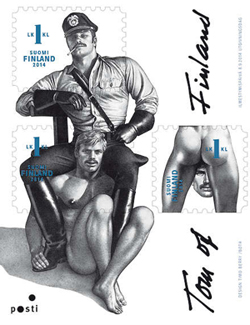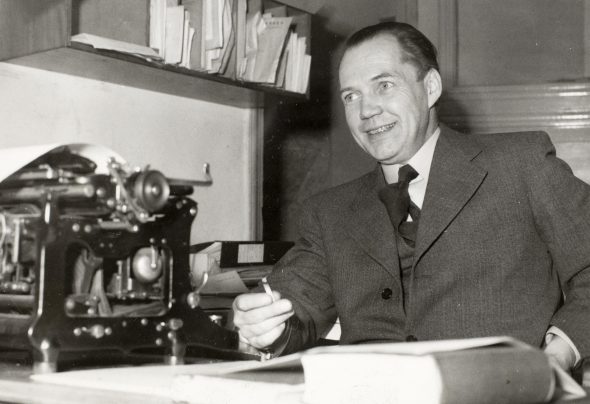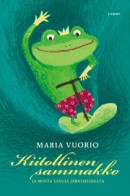Search results for "herbert lomas/www.booksfromfinland.fi/2004/09/no-need-to-go-anywhere"
Star-Eye
31 March 1984 | Archives online, Children's books, Fiction
A story from Läsning för barn (‘Reading for children’,1884). Introduction by George C. Schoolfield
There was once a little child lying in a snowdrift. Why? Because it had been lost.
It was Christmas Eve. The old Lapp was driving his sledge through the desolate mountains, and the old Lapp woman was following him. The snow sparkled, the Northern Lights were dancing, and the stars were shining brightly in the sky. The old Lapp thought this was a splendid journey and turned round to look for his wife who was alone in her little Lapp sledge, for the reindeer could not pull more than one person at a time. The woman was holding her little child in her arms. It was wrapped in a thick, soft reindeer skin, but it was difficult for the woman to drive a sledge properly with a child in her arms.
When they had reached the top of the mountain and were just starting off downhill, they came across a pack of wolves. It was a big pack, about forty or fifty of them, such as you often see in winter in Lapland when they are on the look-out for a reindeer. Now these wolves had not managed to catch any reindeer; they were howling with hunger and straight away began to pursue the old Lapp and his wife. More…
Locomotive
30 June 1981 | Archives online, Fiction, Prose
A short story from Dockskåpet (‘The doll’s house’). Introduction and translation by W. Glyn Jones
What I am about to write might perhaps seem exaggerated, but the most important element in what I have to tell is really my overriding desire for accuracy and attention to detail. In actual fact, I am not telling a story, I am writing an account. I am known for my accuracy and precision. And what I am trying to say is intended for myself: I want to get certain things into perspective.
It is hard to write; I don’t know where to begin. Perhaps a few facts first. Well, I am a specialist in technical drawings and have been employed by Finnish Railways all my life. I am a meticulous and able draughtsman; in addition to that I have for many years worked as a secretary; I shall return to this later. To a very great extent my story is concerned with locomotives; I am consciously using this slightly antiquated word locomotive instead of loco, for I have a penchant for beautiful and perhaps somewhat antediluvian words. Of course, I often draw detailed sketches of this particular kind of engine as part of my everyday work, and when I am so engaged I feel no more than a quiet pride in my work, but in the evenings when I have gone home to my flat I draw engines in motion and in particular the locomotive. It is a game, a hobby, which must not be associated with ambition. During recent years I have drawn and coloured a whole series of plates, and I think that I might be able to produce a book of them some time. But I am not ready yet, not by a long way. When I retire I shall devote all my time to the locomotive, or rather to the idea of the locomotive. At the moment I am forced to write, every day; I must be explicit. The pictures are not sufficient. More…
Being God
30 September 2006 | Fiction, Prose
Extracts from the novel Gud (‘God’, Schildts, 2006)
Side by side, wolves and antelopes graze on the juicy grass.
A deer playfully chases a lion through the bushes.
‘Can you do this?’
Adam crosses his arms in front of his chest and folds his hands back to front so that the right hand is on the left and the left hand is on the right. With his hands folded he twists them downwards and holds them out. Now they point to Eve, still folded, and still with the right hand on the left.
Eve tries. She succeeds, and laughs with delight.
A gentle breeze is blowing from the east, just strongly enough for the couple not to be troubled by the heat, but not so they would feel the need for clothes to keep them warm. More…
The Last War Hero
31 March 1981 | Archives online, Fiction, Prose
An extract from 30-åriga kriget (‘The Thirty Years’ War’). Introduction by Markku Envall
First he heard the noise.
It was an unfamiliar noise and therefore doubly dangerous. Viktor grabbed his machine-pistol. It was a sputtering noise, like that of a cracked machine-gun. But it came from above. And what came from above could be dangerous, Viktor knew.
Then he saw the helicopter, flying just above the tree-tops. He had never seen a helicopter before. Nor had he ever seen the circular markings carried by the aircraft as a sign of the nationality. More and more nations were getting involved, he had had a visit from an American, for all he knew this might be a plane from Australia. The Russians must be in a tight corner if they had to keep sending their allies into the firing line.
He bitterly regretted having let the American sergeant get away.
Now they were after him in real earnest. It must have been the Yankee who had sent them.
Viktor directed a long burst of fire at the plane, which was now hovering almost motionless in the air, like a bee over a flower. The bullets shattered the roboter blades, splinters flew in all directions, and the helicopter dived at a steep angle and plunged into the lake. Viktor leapt to his feet and shouted “Hurrah!” and proceeded to execute a gleeful victory dance. He had shot down an enemy aircraft. More…
Poems
2 February 2009 | Fiction, poetry
Edith Södergran (1892–1923) was born in St Petersburg to Finland-Swedish parents; she later lived in an isolated Karelian village on the Finnish side of the Russian border. She published only six collections of poetry, in her native Swedish, before her untimely death from tuberculosis and poverty at the age of 31. Her bold, intense, sensuous and visionary poetry has made her a classic of Finnish literature. Her letters to her friend, the writer Hagar Olsson, were published in 1955.
Violet dusks
Violet dusks I bear within me from my origins,
naked maidens at play with galloping centaurs...
Yellow sunlit days with gaudy glances,
only sunbeams do true homage to a tender woman’s body...
The man has not come, has never been, will never be...
The man is a false mirror that the sun’s daughter angrily
throws against the rock-face,
the man is a lie that white children do not understand,
the man is a rotten fruit that proud lips disdain.
Pekka the brave
31 December 1983 | Archives online, Children's books, Fiction
An extract from Pekka Peloton (‘Pekka the brave’, 1982). Introduction by Leena Kirstinä
The other ghost was now very close to the Bear. The inhabitants of the Green Woods had pulled back out of its way in terror but the poor Bear couldn’t even get himself to budge. Miserable, he had covered his eyes and slumped down in his own fur.
‘Psst,’ the ghost whispered. ‘Hi, Bear, it’s only me.’ And the ghost poked the Bear in the ribs. ‘It’s me, Pekka. Come on, open your eyes!
But the Bear didn’t make a move to do what Pekka had asked and Pekka began to get worried. He knew the Wolf wouldn’t stay put for a very long time and little by little would start to wonder what this was all about. ‘Dear Bear,’ Pekka said in a louder voice, and punched him as hard as he could. ‘Get up! We haven’t much time … ‘ Pekka’s voice was trembling. ‘Look! I’ve got the key to your courage right here … ‘ More…
The Canada goose
31 December 2008 | Archives online, Fiction, Prose
A short story from Tapaus Sidoroff (‘The Sidoroff case’, WSOY, 2008). Introduction by Kristina Carlson
It was no use even trying the old cart track branching from the main road. I turned off the engine and glanced into the back seat. My aunt lifted the brim of her hat, her bright eyes peering at me questioningly.
‘We can’t get any farther by car. The road’s nothing but rough brush. What do you think, Aunt Alli, can you walk the rest of the way?’
My aunt shook her head and didn’t even bother to answer. She opened the car door and clambered out. A swarm of black flies wafted into the air from the brush at the bottom of the ditch.
‘For heaven’s sakes, there’s sure enough of these flies.’
She fanned at the air with her hat, straightened the hem of her dress and trudged across the ditch, without looking back, through the thicket of willows. In spite of her hip trouble, the old woman made her way in such a hurry that I had my work cut out keeping up with her. More…
Maria Vuorio: Kiitollinen sammakko [The grateful frog]
5 February 2010 | Mini reviews, Reviews
Kiitollinen sammakko ja muita satuja järviseudulta
[The grateful frog and other stories from the lake country]
Kuvitus [Ill. by]: Virpi Penna
Helsinki: Tammi, 2009. 111 p.
ISBN 978-951-31-5017-4
18.20 €, hardback
There is no need to categorise Maria Vuorio’s original yet tradition-conscious prose and poetry as being for readers of a particular age. A father and son, Aatos and Justus, are spending their vacation at a summer cabin. Justus rescues a frog from a well, setting in motion a chain of events that leads the boy to see the world through different eyes. The frog happens to be the king of the frogs, and wishes to reward Justus for his good deed. The stories are wonderful explorations of humble, reticent animals – a perch, a dragonfly, a spider, a crab, a mole. A bumblebee’s leg in a cast has probably never been described with such devotion before. Today, Finnish children’s relationship with nature is limited to the surroundings of the summer cabin. But Vuorio’s view of the relationship of child with nature is still a romantic one. Dazzled by the moonlight, Justus wonders to himself, ‘Why is there such beauty, if no one ever sees it?’
Thunder in the east
31 December 1991 | Archives online, Fiction, Prose
Extract from the novel Colorado Avenue (Söderström & Co, 1991). Introduction by Pia Ingström
Come. We are going to look at schoolmaster Johansson’s photographs.
It is true that Johansson himself died of TB back in 1922, and the collection of glass negatives he left behind – several dozen boxfuls – was destroyed in a peculiar manner. This, however, constitutes no hindrance to us. Where reality falls short, fantasy must intervene. By expanding realistic style beyond the scope of the possible we create a new reality.
To seek to grasp at Time and hold her fast is a dangerous and hopeless undertaking; Time wreaks a terrible revenge on those who seek to rise up against it. Thus, too, was schoolmaster Johansson’s dream of eternity with the help of silver nitrate and glass frustrated. In the spring of 1926 schoolmaster Johansson’s household effects were finally sold by auction. A certain Eskil Holm from Blaxnäs snapped up the glass negatives for a small sum. More…
Fan-male?
29 March 2014 | This 'n' that
 It is one of the enduring peculiarities of Finnish culture, along with the national enthusiasms for heavy metal music and the tango, that Tom of Finland, an erotic artist who specialised in stylised pencil images of muscular and well-endowed men wearing tight or little clothing, should be regarded as a national treasure.
It is one of the enduring peculiarities of Finnish culture, along with the national enthusiasms for heavy metal music and the tango, that Tom of Finland, an erotic artist who specialised in stylised pencil images of muscular and well-endowed men wearing tight or little clothing, should be regarded as a national treasure.
Even more startling, according to our friends abroad, is the news that a collection of Tom’s images is to be issued as postage stamps in September this year, when an exhibition opens in the Postal Museum in Tampere. ‘Sealed with a Secret – Correspondence of Tom of Finland’ displays Laaksonen’s correspondence from the early 1940s to 1991.
As the Finnish post office, Itella Posti, remarks in its press release, Tom of Finland, or Touko Laaksonen (1920–1991), is one of the most well-known Finnish artists around the world. The images selected – which include a pair of buttocks with a moustached face peeking out from between the legs and a man in military uniform entwined with a naked one – stick to the tamer side of Tom’s work, but their stereotypical homoeroticism will nevertheless be, let’s say, striking additions to the envelopes on which they appear.
According to Timo Berry, the graphic artist who made the selection, the stamps portray ‘a sensual life force and being proud of oneself. There is never too much of that in this northern country.’
Opinions will differ as to the artistic merits of Tom of Finland’s work, but one thing is certain: it’s decidedly top-shelf material. The Finnish post office website features a discussion of whom one would send which stamps to: you wouldn’t, obviously, send Tom to your maiden aunt in the countryside, but the conversation doesn’t examine the fact that the images will not only be viewed by the addressee. How would you explain the pictures to your small children, for example?
Postage stamps are, traditionally, regarded as an expression of national identity – in that case it’s debatable what these are expressing, as Finland is not conspicuously friendly to the gay community. There is no gay marriage, and you can only legally change your gender after surgical sterilisation.
So why issue Tom of Finland as public art? We’re stumped. (On the other hand, we’re not convinced you need to regard stamps as an expression of national identity at all…)
Answers on a postcard, please. You choose the stamps. (Tom’s stamps are self-adhesive, by the way. You don’t have to, ahem, lick their backsides.)



